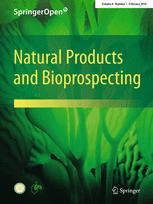|
|
Animal plant warfare and secondary metabolite evolution
Collect
Steffen WÖLL, Sun Hee KIM, Henry Johannes GRETEN, Thomas EFFERTH
Natural Products and Bioprospecting. 2013, 3 (1): 1-7.
DOI: 10.1007/s13659-013-0004-0
The enduring discussion, why plants produce secondary metabolites with pharmacologically and toxicologically active towards mammals traces back to the eminent role of medicinal plants in the millennia-old history of manhood. In recent years, the concept of an animal plant warfare emerged, which focused on the co-evolution between plants and herbivores. As a reaction to herbivory, plants developed mechanical defenses such as thorns and hard shells, which paved the way for adapted animal physiques. Plants evolved further defense systems by producing chemicals that exert toxic effects on the animals that ingest them. As a result of this selective pressure, animals developed special enzymes, e.g. cytochrome P450 monooxigenases (CYP450) that metabolize xenobiotic phytochemicals. As a next step in the evolutionary competition between plants and animals, plants evolved to produce non-toxic pro-drugs, which become toxic only after ingestion by animals through metabolization by enzymes such as CYP450. Because these sequestered evolutionary developments call to mind an arms race, the term animal plant warfare has been coined. The evolutionary competition between plants and animals may help to better understand the modes of action of medicinal plants and to foster the efficient and safe use of phytotherapy nowadays.
References |
Related Articles |
Metrics
|
|
|
Ten new aurovertins from cultures of the basidiomycete Albatrellus confluens
Collect
Hua GUO, Tao FENG, Zheng-Hui LI, Ji-Kai LIU
Natural Products and Bioprospecting. 2013, 3 (1): 8-13.
DOI: 10.1007/s13659-012-0088-y
Aurovertins J-S (1-10), together with four known metabolites, aurovertins B, C, E, and I (11-14), were isolated from cultures of the basidiomycete Albatrellus confluens. The structures of compounds 1-10 were elucidated on the basis of extensive spectroscopic analysis. All compounds were evaluated for their cytotoxic activities on five tumor cell lines.
References |
Related Articles |
Metrics
|
|
|
Epigenetic modifier-induced biosynthesis of novel fusaric acid derivatives in endophytic fungi from Datura stramonium L.
Collect
Han-Jing CHEN, Takayoshi AWAKAWA, Jie-Yin SUN, Toshiyuki WAKIMOTO, Ikuro ABE
Natural Products and Bioprospecting. 2013, 3 (1): 20-23.
DOI: 10.1007/s13659-013-0010-2
The treatment of fungi with DNA methyltransferase (DNMT) and/or histone deacetylase (HDAC) inhibitors is a promising way to activate secondary metabolite biosynthetic pathways that are dormant under normal conditions. In this study, we included an HDAC inhibitor, suberoylanilide hydroxamic acid (SBHA), in the culture medium of endophytic fungi isolated from the medicinal plant Datura stramonium L. The production of two compounds was induced in the culture supplemented with SBHA, and their structures were determined to be the fusaric acid derivatives 5-butyl-6-oxo-1,6-dihydropyridine-2-carboxylic acid and 5-(but-9-enyl)-6-oxo-1,6-dihydropyridine-2-carboxylic acid. The result confirmed that the use of chemical epigenetic modifiers is an effective technique for promoting the expression of silent biosynthetic pathways to produce unique secondary metabolites.
References |
Related Articles |
Metrics
|
|
|
Daphmacrodins A and B, alkaloids from Daphniphyllum macropodum
Collect
Ming-Ming CAO, Hong-Ping HE, Yu-Cheng GU, Qiang ZHANG, Xiao-Nian LI, Guo-Ying ZUO, Ying-Tong DI, Chun-Mao YUAN, Shun-Lin LI, Yu ZHANG, Xiao-Jiang HAO
Natural Products and Bioprospecting. 2013, 3 (1): 29-32.
DOI: 10.1007/s13659-012-0095-z
Two new daphnicyclidin-type Daphniphyllum alkaloids, daphmacrodins A and B (1 and 2) were isolated from the leaves and stems of Daphniphyllum macropodum. Their structures were elucidated by extensive spectroscopic techniques, including 2D NMR spectroscopy and mass spectrometry. The relative configuration of 1 was further confirmed by a single-crystal X-ray diffraction analysis. Their cytotoxic activities against five human cancer cell lines, pesticidal activities against brine shrimp (Artemia salina), and antibacterial activities against five standard bacterial and fungal strains were evaluated. The structure of 1 was successfully transformed to 2 by a chemical method.
References |
Related Articles |
Metrics
|
|
|
New triterpenoids from the kernels of Azadirachta indica
Collect
Hong-Wei WANG, Jie-Qing LIU, Jin-Xiong CHEN, Yuan-Feng YANG, Yu-Xin YAN, Zhong-Rong LI, Ming-Hua QIU
Natural Products and Bioprospecting. 2013, 3 (1): 33-37.
DOI: 10.1007/s13659-013-0005-z
Three new limonoids (1-3) and a new intact triterpenoid (4), along with three known constituents (5-7), were isolated from the dried kernels (after extracting azadirachtin) of Azadirachta indica. The structures of the new compounds 1-benzoyl-3-deacetyl-1-detigloyl salannin (1), 7-tigloyl-12-oxo vilasini (2), azadiralactone (3) and azadirahemiacetal (4) were elucidated by means of spectroscopic analysis. The cytotoxities of these isolated constituents were assayed.
References |
Related Articles |
Metrics
|
|

